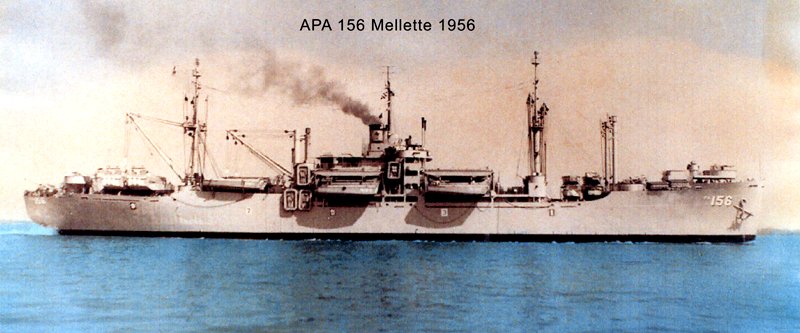
APA 156 USS Mellette |
||||
| Click Here for USS Mellette Main Page | ||||
 |
Specifications:
Displacement 6,873 t.(lt) 14,837 t.(fl)
Length 455'
Beam 62'
Speed 19 kts.
Complement 56 Officers 480 Enlisted
Troop Accommodations 86 Officers 1,475 Enlisted
Cargo Capacity 150,000 cu. ft, 2,900 tons
Boats 2 LCM, 12 LCVP, 3 LCPU
Armament 1 5"/38 dual-purpose gun mount, 4 twin 40mm gun
mounts, 10 single 20mm gun mounts
Propulsion 1 Westinghouse geared turbine, 2 Babcock and Wilcox
header-type boilers, 1 propeller, Design shaft horsepower 8,500
Mellette
A county in southern South Dakota named for Arthur C. Mellette, the first Governor of the State.
Mellette (APA 156) was launched by Oregon Shipbuilding Corp., Portland, Oreg., 4 August 1944; sponsored by Mrs. Clarissa Bickford; acquired from the Maritime Commission on a loan‑charter basis; and commissioned 27 September 1944, Comdr. F. H. Spring, USNR, in command.
In November 1944 Mellette followed a San Pedro, shakedown cruise with a voyage to the Hawaiian Islands for training operations. She conducted amphibious troop, gunnery, and tactical exercises off Maui into January 1945. On 27 January she joined TG 51.1 and got underway for Iwo Jima. With units of the 4th Marine Division embarked, she steamed west, via Eniwetok and Saipan, arriving off the Volcano Islands to participate in the initial assault 19 February. She remained off the eastern beaches of Iwo Jima for the next 6 days, unloading supplies and taking on casualties. On the 25th she sailed for Saipan where she disembarked her wounded passengers and began preparations for the upcoming Okinawa campaign.
Through the next month Mellette trained off Tinians’ western beaches with TG 51.2 and on 27 March weighed anchor and headed for the Ryukyus. On 1 April she was off Okinawa and at 0631 commenced disembarking units of the 2d Marine Division in diversionary landings along the island’s southeastern coast. Her mission completed by mid‑morning. she reembarked her marines and sailed to the main assault area to stand by until needed. There she remained until ordered back to Saipan on the 11th.
She disembarked the marines at Saipan on the 14th and remained there until 4 June when she began carrying men and cargo among the Marianas and Solomons. In July she carried reinforcements, the Army’s 24th Infantry Regiment, to Kerama Retto. Back at Saipan when the Japanese capitulation was announced, 15 August. Mellette immediately took on men of the 6th Marine Division and sailed for Honshu. Arriving with the first wave of occupation troops, she disembarked the marines at Yokosuka Naval Base on the 30th, witnessed official surrender in Tokyo Bay 2 September, and then returned to Saipan to taken on men of the 2d Marine Division for transportation to Nagasaki.
Next assigned to “Magic Carpet” duty, she completed two voyages between the western Pacific and Seattle before 21 January 1946 when she got underway for the east coast and inactivation. Arriving at Norfolk, Va., 3 February, she decommissioned 25 June and entered file Reserve Fleet at Yorktown, Va.
With the outbreak of hostilities in Korea, Mellette was reactivated, recommissioning 18 October 1950. For the next 4 years she operated primarily along the east coast, participating in fleet operations and exercises from Nova Scotia to the Caribbean. During that period she served with the 6th Fleet in the Mediterranean 8 September 1933 to 4 February 1954. She decommissioned 18 June 1955 and joined the Charleston, S.C., group of the Atlantic Reserve Fleet. Berthed at Charleston for the next 5 years, she was transferred to the National Defense Reserve Fleet in June 1960. Struck from the Naval Register 1 July 1960, she has remained berthed with the James River group into 1969.
Mellette received two battle stars for World War II service.